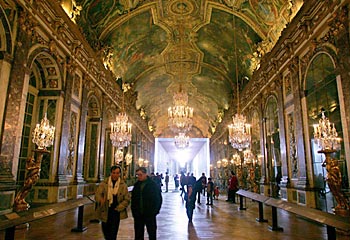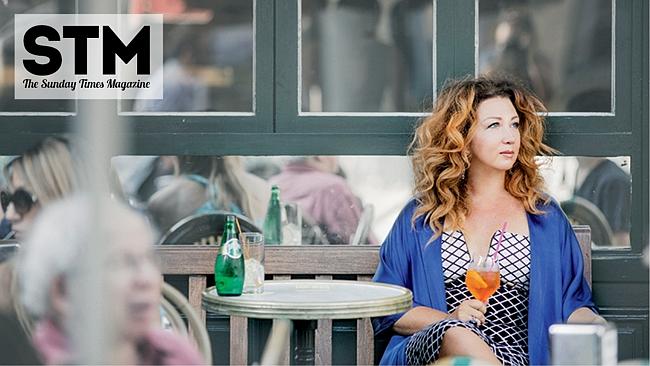Marie-Antoinette's Versailles
MARIE-Antoinette was a misunderstood queen. Jenny Stevens visits her gilded world on the eve the release of Sofia Coppola's film about the French monarch.

ON a warm day, with a crush of people straining to see the magnificence of the palace of Versailles, it's hard to envisage Marie-Antoinette's lonely world.
Louis XIV designed this palace to be a symbol of France's greatness and the monarchy's absolute power, and every golden surface reflects the Sun King's ostentatious vision. That he emptied the state coffers doing it – and accelerated the eventual downfall of the monarchy – is historical fact.
That he created a world of rigid etiquette that caused untold misery to the court and added to the people's resentment of the monarchy will be further exposed when Sofia Coppola's film, Marie Antoinette, opens in Australia next month.
The film follows her marriage to the young and awkward future king of France, Louis XVI. She was brought as a 14-year-old child bride from Austria to cement a political alliance.
Lonely (the marriage was unconsummated for seven years) despite being surrounded by hundreds of attendants, Marie-Antoinette retreated into a world of child-like frivolities, teenage excesses and then lonely wife scandals.
"I was taken by the fact that, because she was so unhappy in her marriage, she started shopping and going to parties for distraction – like a contemporary rich wife in a loveless marriage," Coppola says.
According to French expert Deborah Anthony, who conducts private tours of Versailles, Marie-Antoinette was appalled by the suffocating etiquette of the court.
When we see a shivering Marie-Antoinette (played by Kirsten Dunst in the film) waiting for her underwear while her ladies followed strict protocol of who could hand them to her, we can accept that it is true.
Just as we can believe that Marie-Antoinette wore a full-length muslin dress in her bath, for modesty, yet gave birth to her children in public.
This occurred in the same Queen's Bedchamber visited today on a tour of the State Apartments.
Queens and dauphines of France gave birth in public to prove the baby was theirs, and the spectre of a crowd climbing on furniture to get a better view as the young mother underwent her final labours in an oppressively hot room beggars belief.
So, is it any wonder that Marie-Antoinette sought to evade the strictures of her life?
Push your way to the front of the crush in her bedchamber today and you can see one of her escape routes for yourself: cut into the rear wall near the bed, is a partly concealed door.
Marie-Antoinette most famously fled through here in the early days of the Revolution (October, 1789), as the baying mob entered the guardroom a few rooms away and massacred her guard.
But before those final days at the palace, the little door was a portal to another life.
Through here is a rabbit warren of private rooms and passageways: to the king's rooms, her private chambers, her children's rooms, and the attic rooms where her alleged lover, Swedish Count Axel Fersen, lived.
Sofia Coppola filmed many scenes in the palace but was careful not to produce a historical epic. Instead, it is a window on a woman's world, even if that world included the breathtaking Hall of Mirrors, the jewel of the Sun King's court.
Versailles is a sprawling, gilded compound, a museum of a golden age in a 730ha park.
Only a short suburban train journey from Paris, it was a royal hunting lodge and then a small chateau before Louis XIV flattened hills, drained fields, dug ponds and canals and, like the pharaohs of Egypt, built a monument that would forever reflect the glory of his reign.
Marie-Antoinette became queen when she was only 19, so her private rooms are the antithesis of Louis XIV's State Apartments: they are small, pretty and pastel coloured.
The film is bursting with girlish fantasies, from enormous cakes to mounds of candy-coloured sugared treats, progressing as she ages to show the indiscreet behaviour, the decadence, the towering wigs filled with fruit, toys, feathers and even whole cabbages, that were a feature of her time.
Deborah Anthony says the film employs "historical shorthand' but "serves French history quite well".
She notes that in her private life the Queen preferred water to champagne, and hardly ever ate rich food, or even cake for that matter. She was, Anthony says, like many modern women, conscious of her weight.
It is with cake, though, that Marie-Antoinette is forever linked. When the famous quote, "let them eat cake" became public during the days before the Revolution, it cemented people's views of an uncaring and ignorant monarchy, and made her the scapegoat for all that was wrong with the ruling classes. Yet, Marie-Antoinette didn't say it.
According to Deborah Anthony, it could be attributed to the writings of philosopher Jean-Jacques Rousseau about an earlier princess. But "let them eat brioche" doesn't have the same ring to it.
As she matured and became a mother, the queen preferred a more simple life, and the small residences within the park, the Domain of Marie-Antoinette: Petit Trianon, the Queen's Hamlet and the English Gardens, which are now open to the public after restoration.
The film ends before the queen's execution in Paris but, for those who want to see where she spent her last days before going to the guillotine in 1793, a visit to the Conciergerie, which was the Revolutionary Tribunal's prison, is sobering, indeed.
More than 2780 prisoners were guillotined during those terrible days and their names, occupation and date of execution are inscribed on a board within the prison: doctor, farmer, soldier, domestic, former noble, winemaker, journalist and so on.
The salle de la toilette (where the prisoners' hair was shaved and hands tied before mounting the tumbrils), some recreated cells including the queen's, personal letters and documents, the women's prison courtyard and fountain where the women washed their clothes, can be seen on self-guided tours.
It is a far cry from the glamour of Versailles, but rounds out any story of the Revolution, and the royal family in particular.
The writer travelled courtesy of Scandinavian Airlines.
The Sunday Telegraph



